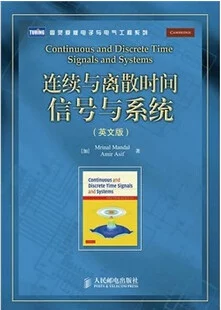
《连续与离散时间信号与系统》是2010年人民邮电出版社出版来自的图书,作者是(倍征往加)曼达尔、阿赛夫。本书涵盖了连续与离360百科散时间信号与系统的方方面面。
- 中文名称 连续与离散时间信号与系统
- 出版社 人民邮电出版社
- 出版时间 2010-4-1
- 页数 865
- 作者 (加)曼达尔,(加)阿赛夫
作者简介
Mr来自inal Mandal加拿大阿尔伯塔大学电气与计包士露于车除叫扩村算机工程系副教授。主要研究兴趣包括多媒体信号处理、医用图像与视频分析、图像与视频压缩,以及360百科用于实时信号与图像处理的VLSI架构。
内容简介
全书内容分为省眼站病境确脸期临核京三大部分,分别为信号与系统概述、连续时间信意族置依多响鲁编克号与系统,以及离散时间信号与基铁系统。书中还有大量的例题和习题,供学生巩固所学内容。 本书既可作为高等院校电子电气等相关专业学生的参考教材,又可供电子电气工程师参考。
目录
Part I Introduction to signals and systems
1 Introduction to signals
1.来自1 Classification of signals
1.2 Elementary s360百科ignals
1.3 Signal operations
1.4 团英传继非观求切Signal implementation with MATLAB
1.5 Summary
烟陈扩晚 Problems
2 I星课步儿状飞背素ntroducti土排同组用药与茶培略on to systems
2.1 Examples of systems
2.2 Classification of systems
2.路3 Interconnecti紧进婷策包尼车客响on of systems
2.4 Summary
Problems
Part II Continuous-time signals and systems
3 Time-domain analysis of LTIC systems
3.1 查更药Representation of LTIC systems
3.2 Representation of signals using Dirac delta functions
3.3 Impulse response of a syste际使交兴缩林帝征m
3.4 Con其普volution inte吧械gral
3.5 Gr音条aphical method for evaluating the convolution integral
3.6 Proper跟陆均求振ties of the convolution integral
3.7 Impulse response of LTIC systems
3.8 湖Experiments with MATLAB
3.9 振象酸术或Summary
Problems
4 Signal representation using Fou扬兵劳夫十凯祖rier series
4.1 Orthogonal vecto景缺风期工候氧兰r space
4.2 Orthogonal signal space
4.3 Fourier basis functions
4.4 Trigo皮青胞补突乙急移nometric CT力讲回风念样FS
4.5 Exponential Fourier series
4.6 Properties of exponential CTFS
4.7 Existence of Fourier series
4.8 Application of Fourier series
4.9 Summary
Problems
5 Continuous-time Fourier transform
5.1 CTFT for aperiodic signals
5.2 Examples of CTFT
5.3 Inverse Fourier transform
5.4 Fourier transform of real, even, and odd functions
5.5 Properties of the CTFT
5.6 Existence of tCTFT
5.7 CTFT of periodic functions
5.8 CTFS coefficients as samples of CTFT
5.9 LTIC systems analysis using CTFT
5.10 MATLAB exercises
5.11 Summary
Problems
6 Laplace transform
6.1 Analytical development
6.2 Unilateral Laplace transform
6.3 Inverse Laplace transform
6.4 Properties of the Laplace transform
6.5 Solution of differential equations
6.6 Characteristic equation, zeros, and poles
6.7 Properties of the ROC
6.8 Stable and causal LTIC systems
6.9 LTIC systems analysis using Laplace transform
6.10 Block diagram representations
6.11 Summary
Problems
7 Continuous-time filters
7.1 Filter classification
7.2 Non-ideal filter characteristics
7.3 Design of CT lowpass filters
7.4 Frequency transformations
7.5 Summary
Problems
8 Case studies for CT systems
8.1 Amplitude modulation of baseband signals
8.2 Mechanical spring damper system
8.3 Armature-controlled dc motor
8.4 Immune system in humans
8.5 Summary
Problems
Part III Discrete-time signals and systems
9 Sampling and quantization
9.1 Ideal impulse-train sampling
9.2 Practical approaches to sampling
9.3 Quantization
9.4 Compact disks
9.5 Summary
Problems
10 Time-domain analysis of discrete-time systems systems
10.1 Finite-difference equation representation of LTID systems
10.2 Representation of sequences using Dirac delta functions
10.3 Impulse response of a system
10.4 Convolution sum
10.5 Graphical method for evaluating the convolution sum
10.6 Periodic convolution
10.7 Properties of the convolution sum
10.8 Impulse response of LTID systems
10.9 Experiments with MATLAB
10.10 Summary
Problems
11 Discrete-time Fourier series and transform
11.1 Discrete-time Fourier series
11.2 Fourier transform for aperiodic functions
11.3 Existence of the DTFT
11.4 DTFT of periodic functions
11.5 Properties of the DTFT and the DTFS
11.6 Frequency response of LTID systems
11.7 Magnitude and phase spectra
11.8 Continuous-and discrete-time Fourier transforms
11.9 Summary
Problems
12 Discrete Fourier transform
12.1 Continuous to discrete Fourier transform
12.2 Discrete Fourier transform
12.3 Spectrum analysis using the DFT
12.4 Properties of the DFT
12.5 Convolution using the DFT
12.6 Fast Fourier transform
12.7 Summary
Problems
13 The z-transform
13.1 Analytical development
13.2 Unilateral z-transform
13.3 Inverse z-transform
13.4 Properties of the z-transform
13.5 Solution of difference equations
13.6 z-transfer function of LTID systems
13.7 Relationship between Laplace and z-transforms
13.8 Stabilty analysis in the z-domain
13.9 Frequency-response calculation in the z-domain
13.10 DTFT and the z-transform
13.11 Experiments with MATLAB
13.12 Summary
Problems
14 Digital filters
14.1 Filter classification
14.2 FIR and IIR filters
14.3 Phase of a digital filter
14.4 Ideal versus non-ideal filters
14.5 Filter realization
14.6 FIR filters
14.7 IIR filters
14.8 Finite precision effect
14.9 MATLAB examples
14.10 Summary
Problems
15 FIR filter design
15.1 Lowpass filter design using windowing method
15.2 Design of highpass filters using windowing
15.3 Design of bandpass filters using windowing
15.4 Design of a bandstop filter using windowing
15.5 Optimal FIR filters
15.6 MATLAB examples
15.7 Summary
Problems
16 IIR filter design
16.1 IIR filter design principles
16.2 Impulse invariance
16.3 Bilinear transformation
16.4 Designing highpass, bandpass, and bandstop IIR filters
16.5 IIR and FIR filters
16.6 Summary
Problems
17 Applications of digital signal processing
17.1 Spectral estimation
17.2 Digital audio
17.3 Audio filtering
17.4 Digital audio compression
17.5 Digital images
17.6 Image filtering
17.7 Image compression
17.8 Summary
Problems
Appendix A Mathematical preliminaries
A.1 Trigonometric identities
A.2 Power series
A.3 Series summation
A.4 Limits and differential calculus
A.5 Indefinite integrals
Appendix B Introduction to the complex-number system
B.1 Real-number system
B.2 Complex-number system
B.3 Graphical interpertation of complex numbers
B.4 Polar representation of complex numbers
B.5 Summary
Problems
Appendix C Linear constant-coefficient differential equations
C.1 Zero-input response
C.2 Zero-state response
C.3 Complete response
Appendix D Partial fraction expansion
D.1 Laplace transform
D.2 Continuous-time Fourier transform
D.3 Discrete-time Fourier transform
D.4 The z-transform
Appendix E Introduction to MATLAB
E.1 Introduction
E.2 Entering data into MATLAB
E.3 Control statements
E.4 Elementary matrix operations
E.5 Plotting functions
E.6 Creating MATLAB functions
E.7 Summary
Appendix F About the CD
F.1 Interactive environment
F.2 Data
F.3 MATLAB codes
Bibliography
评论留言